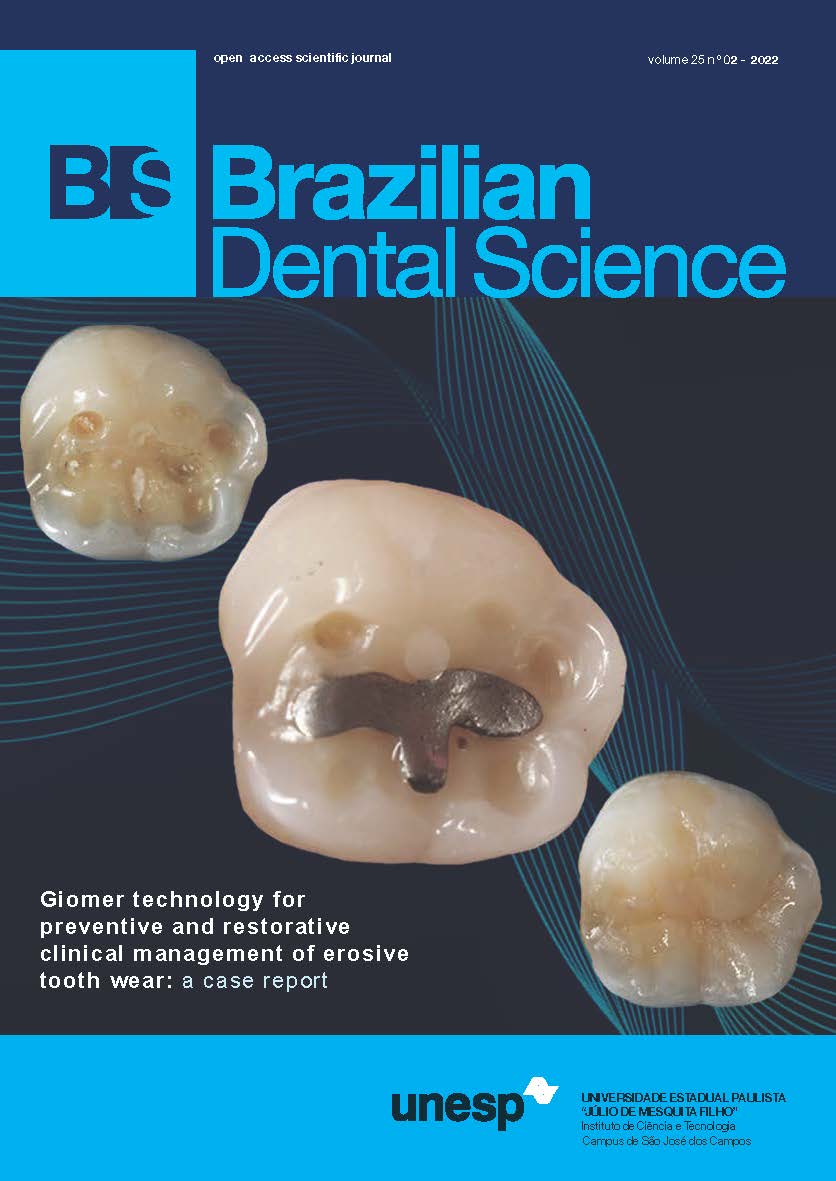Effect of resin infiltration and bleaching on surface roughness and microhardness of human enamel with induced white spot lesions
DOI:
https://doi.org/10.4322/bds.2022.e3026Resumo
Objective: To comparatively evaluate the effect of resin infiltration, bleaching and bleaching followed by resin
infiltration on the surface roughness and microhardness of human enamel with induced white spot lesions
(WSLs) and their resistance to acidic challenge. Material and Methods: Sixty human specimens were randomly
divided into three groups (n=20) according to the treatment modality applied; group I Icon® resin infiltration,
group II bleaching and group III bleaching followed by Icon® resin infiltration. For each treatment modality, 10
specimens were tested for surface roughness and another 10 for microhardness. WSLs were artificially induced
in all specimens and after treatment, all specimens were subjected to acidic challenge. Surface roughness was
measured by the tapping mode of the atomic force microscope (AFM) and microhardness was measured by
digital Vickers hardness tester at baseline, after induction of WSLs, after treatment and after acidic challenge.
Results: Groups I and III showed significant reduction in surface roughness after treatment, while group II showed
significant increase. Groups I and III showed significant increase in the microhardness after treatment, while
group II showed insignificant increase. The three tested groups showed significant increase in surface roughness
values and significant reduction in microhardness after acidic challenge. Conclusion: Resin infiltration and
bleaching followed by resin infiltration reduced the surface roughness and enhanced the microhardness of the
WSLs. The three treatment modalities failed to resist acidic challenge resulting in increasing surface roughness
and reducing microhardness.
KEYWORDS
AFM; Bleaching; Microhardness; Resin infiltration; White spot lesions.
Downloads
Downloads
Publicado
Como Citar
Edição
Seção
Licença
TRANSFERÊNCIA DE DIREITOS AUTORAIS E DECLARAÇÃO DE RESPONSABILIDADE
Toda a propriedade de direitos autorais do artigo "____________________________________________________________________" é transferido do autor(es) para a CIÊNCIA ODONTOLÓGICA BRASILEIRA, no caso do trabalho ser publicado. O artigo não foi publicado em outro lugar e não foi submetido simultaneamente para publicação em outra revista.
Vimos por meio deste, atestar que trabalho é original e não apresenta dados manipulados, fraude ou plágio. Fizemos contribuição científica significativa para o estudo e estamos cientes dos dados apresentados e de acordo com a versão final do artigo. Assumimos total responsabilidade pelos aspectos éticos do estudo.
Este texto deve ser impresso e assinado por todos os autores. A versão digitalizada deverá ser apresentada como arquivo suplementar durante o processo de submissão.




























